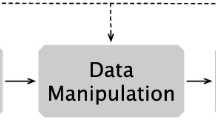Abstract
Permutation exists in various domains such as mathematics, combinatorics, and computer science. Enumerating each permutation, as well as the multivariate information among different items, allows us, for example, to observe distribution, similarity, and dissimilarity of all possible permutations and select a satisfactory permutation or solution. However, the number of permutations increases dramatically along with the number of items in the permutation, which makes it challenging for users to evaluate potential solutions and identify interesting insights. In this paper, we propose PermVizor, a novel and scalable visualization system that aims assisting users exploring the arrangement, distribution, and comparison of permutations. Necessary and comprehensive analysis of requirements is presented for visualization of permutations. PermVizor enables users to explore overall distribution of each permutation with a glyph-based MDS view, investigate statistical information of selected permutations with a parallel coordinates view, and examine detailed arrangement of the items as well the multivariate information among them for each permutation with pixel-based and block-based PermView. Case studies are conducted on classical datasets such as the axis reordering issue in parallel coordinate data and permutation of traveling salesman problem, which shows that PermVizor could facilitate users in exploring unexpected and desired permutations and confirm their finding and decisions in expected permutations.
Graphic abstract












Similar content being viewed by others
References
Apostolico A, Hein J (2005) Combinatorial pattern matching, vol 213, 1st edn. Springer, Berlin, pp 8–289
Bertin J (1981) Graphics and graphic information processing. In: Graphics and graphic information processing, pp 24–31. https://doi.org/10.1515/9783110854688
Blaas J, Botha CP, Post FH (2008) Exetensions of parallel coordinates for interactive exploration of large multi-timepoint data sets. IEEE Trans Vis Comput Gr 14(6):1436–1443
Eisen MB, Spellman PT, Brown PO, Botstein D (1998) Cluster analysis and display of genome-wide expression patterns. Proc Natl Acad Sci USA 95(25):14863–14868
Friendly M, Kwan E (2003) Effect ordering for data displays. Comput Stat Data Anal 43(4):509–539
Heinrich J, Stasko J, Weiskopf D (2012) The parallel coordinates matrix. In: Proceeding of eurographics conference on visualization—short papers, pp 37–41. https://doi.org/10.2312/PE/EuroVisShort/EuroVisShort2012/037-041
Hurley CB, Oldford RW (2010) Pairwise display of high-dimensional information via eulerian tours and hamiltonian decompositions. J Comput Gr Stat 19(4):861–886. https://doi.org/10.1198/jcgs.2010.09136
Johansson J, Forsell C (2016) Evaluation of parallel coordinates : overview. Categ Guidel Future Res 22(1):579–588. https://doi.org/10.1109/TVCG.2015.2466992
Kendall MG (1938) A new measure of rank correlation. Biometrika 30(1/2):81–93
Kim B, Lee B, Seo J (2007) Visualizing set concordance with permutation matrices and fan diagrams. Interact Comput 19(5–6):630–643. https://doi.org/10.1016/j.intcom.2007.05.004
Liiv I (2010) Seriation and matrix reordering methods: an historical overview. Stat Anal Data Min ASA Data Sci J 3(2):70–91
Liu CL (1968) Introduction to combinatorial mathematics. McGraw-Hill College, New York, pp 1–18
Lu LF, Huang ML, Huang TH (2012) A new axes re-ordering method in parallel coordinates visualization. In: Proceedings of 11th international conference on machine learning and applications, vol 2. ICMLA, pp 252–257. https://doi.org/10.1109/ICMLA.2012.148
Lu LF, Huang ML, Zhang J (2016) Two axes re-ordering methods in parallel coordinates plots. J Vis Lang Comput 33(1):3–12
Massini A (2003) All-to-all personalized communication on multistage interconnection networks. Elsevier, Amsterdam
McCoy NH (1968) Introduction to modern algebra. Allyn and Bacon, Boston
Munakata T, Barták R (2006) Combinatorics in logic programming: implementations and applications. Int J Inf Technol Intell Comput 1(2):419–428
Mycielski J, Rozenberg G, Salomaa A (1997) Structures in logic and computer science. Springer, Berlin
Paterson T, Graham M, Kennedy J, Law A (2011) Evaluating the VIPER pedigree visualisation: detecting inheritance inconsistencies in genotyped pedigrees. In: IEEE symposium on biological data visualization, BioVis 2011-proceedings, pp 119–126. https://doi.org/10.1109/BioVis.2011.6094056
Perin C, Dragicevic P, Fekete JD (2014) Revisiting Bertin matrices: new interactions for crafting tabular visualizations. IEEE Trans Vis Comput Gr 20(12):2082–2091. https://doi.org/10.1109/TVCG.2014.2346279
Pilhofer A, Gribov A, Unwin A (2012) Comparing clusterings using Bertin’s idea. IEEE Trans Vis Comput Gr 18(12):2506–2515. https://doi.org/10.1109/TVCG.2012.207
Roberts F, Tesman B (2009) Applied combinatorics. CRC Press, Boca Raton
Stallings W (2003) Cryptography and network security: principles and practice, vol 46, 3rd edn. International Annals of Criminology, Rome, pp 121–136
Stoll RR (2013) Linear algebra and matrix theory. Courier Corporation, Mineola
Sugiyama K (2002) Graph drawing and applications for software and knowledge engineers, vol 11. World Scientific, Singapore
Sun GD, Wu YC, Liang RH, Liu SX (2013) A survey of visual analytics techniques and applications: state-of-the-art research and future challenges. J Comput Sci Technol 28(5):852–867. https://doi.org/10.1007/s11390-013-1383-8
Tennekes M, De Jonge E (2014) Tree colors: color schemes for tree-structured data. IEEE Trans Vis Comput Gr 20(12):2072–2081. https://doi.org/10.1109/TVCG.2014.2346277
Yang Y, Wang J (2004) Routing permutations on optical baseline networks with node-disjoint paths. In: Proceedings of tenth international conference on parallel and distributed systems. ICPADS 2004. IEEE, pp 65–72
Acknowledgements
This work is partly supported by National Natural Science Foundation of China (No. 61972356), Zhejiang Provincial Natural Science Foundation of China (No. LY19F020026), National Natural Science Foundation of China (No. 61602409), Zhejiang Povincial Key Research and Development Program of China No. 2019C01009), and Fundamental Research Funds for the Provincial Universities of Zhejiang (No. RF-C2019001).
Author information
Authors and Affiliations
Corresponding author
Additional information
Publisher's Note
Springer Nature remains neutral with regard to jurisdictional claims in published maps and institutional affiliations.
Electronic supplementary material
Below is the link to the electronic supplementary material.
Rights and permissions
About this article
Cite this article
Sun, G., Zhou, Z., Chang, B. et al. PermVizor: visual analysis of multivariate permutations. J Vis 22, 1225–1240 (2019). https://doi.org/10.1007/s12650-019-00599-w
Received:
Accepted:
Published:
Issue Date:
DOI: https://doi.org/10.1007/s12650-019-00599-w




